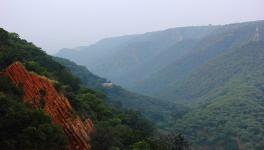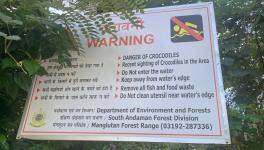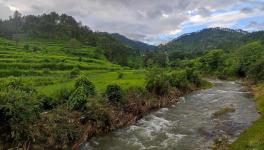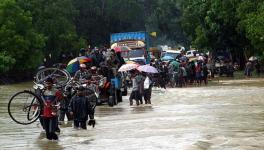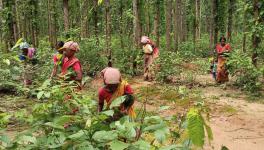Chamoli Disaster: Locals and Workers Face Horror of Development
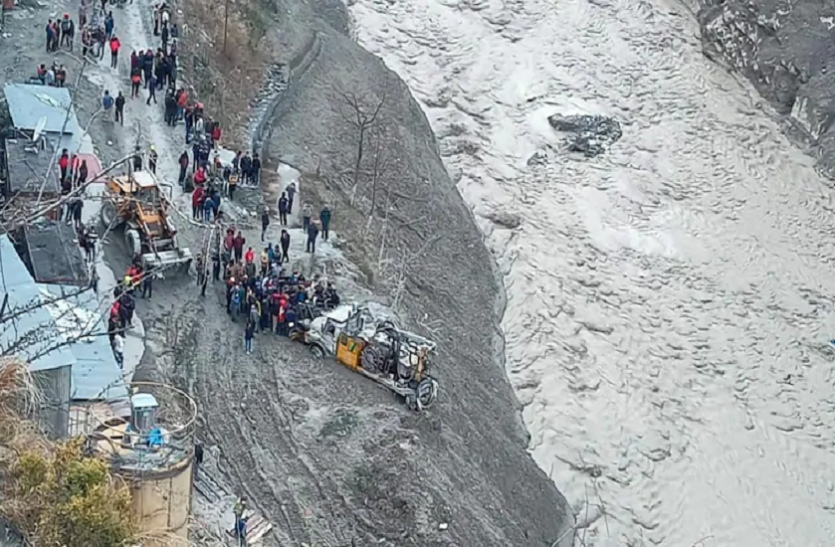
Image Courtesy: Patrika
Raini village in Chamoli district is the epicentre of the tragedy that befell Uttarakhand on Sunday morning. Disaster struck the village when the Rishiganga, a tributary of the Alaknanda river, swelled and triggered a massive flood in the hilly state. The floodwaters hurtled downstream from dizzy heights, apparently after a tremendous volume of snowmelt, or a mammoth chunk of a glacial lake, or a hidden icy lake in a glacier, joined the waters of the Rishiganga, washing away everything in its path.
Scientists are yet to ascertain the exact cause, but the Rishiganga hydropower plant burst open on Sunday as a result of it. It was being constructed in an environmentally fragile buffer zone that is a stone’s throw from the Nandadevi Biosphere Reserve. The resultant deluge swept away 18 residents of Raini village and at least 202 people, mostly labourers, at the Rishiganga plant. The NTPC-owned Vishnughad Tapovan power plant, located slightly downstream, also bore the brunt of the tragedy.
Raini is the cradle of the famous Chipko Movement of the seventies. It got locals to fight the establishment against the havoc being caused by these projects to the environment, including the non-stop large-scale deforestation. The residents saw over the decades how their forests were depleted and incessant man-made fires exploded in and around the region.
Sangram Singh, a former sarpanch of Raini, had even filed a petition in 2019 in the Nainital High Court against the large-scale dynamite blasts that were being triggered in the area for mining purposes. He told this reporter, “Our entire village had warned the local authorities and senior politicians about these hazardous activities but we were constantly ignored. The nexus between contractors and politicians proved far too strong.”
The result is that on this fateful Sunday, middle-aged Madhavi Singh, wife of Bhopal Singh, who had gone to collect firewood along the banks of the river was swept away under the avalanche of water, says Sangram Singh.
“Another victim is young Yashpal Rana, son of Vishoda Rana and Dharvan Singh Rana, who had taken goats to graze. All his animals have also washed away. This is a real tragedy because he got married not long agao, and has an eight-month-old son too,” said Sangram Singh.
A pall of gloom hangs over the village. Three bridges that connected Raini to the outside world have also been washed away. In the cradle of the Chipko Movement, villagers had already come to see the courts as their last resort. But no government or court can bring back their loved ones or their livelihoods and they have to live with the shock of the events forever.
There is still uncertainty about whether this latest calamity occurred because of a glacial break or was triggered by an avalanche. Experts are on their way to the site of the tragedy and the upper reaches of this sensitive biosphere, but the locals would say it is too little too late.
Dr. Ravi Chopra of the People’s Science Institute says, “Yesterday’s occurrence was not a glacier outburst. It snowed on the north face of the Nanda Devi peak last week. On Sunday morning there was an avalanche in the Rishi Ganga Valley which brought a lot of debris with it, and large boulders. They smashed the 11 megawatts Rishi Ganga dam.”
Thereafter, the flood barrelled into the Dhauli Ganga West Valley and damaged the barrage of the Tapovan Vishnugad 520 megawatts project. The water entered the intake tunnel too, where at least 50 people are said to have been working. “Thirty to thirty-five labourers are feared to have been washed away. How many workers there were in the tunnel is unknown,” says Dr. Chopra.
Some years ago, Dr. Chopra was approached by the Union Ministry of Environment and Forests to study the impact of power projects on the Upper Himalayas. He had recommended in his report to the ministry, “The regions at an elevation above 2,000 metres in Uttarakhand’s valleys are unsuitable for hydroelectric projects.”
The MoEF chose to ignore his report. Yet it was not just his recommendations. The Centre ignored all other reports that cautioned against these and other projects and gave the green signal to a gaggle of “development” works without even securing proper environmental clearances.
The Rishi Ganga project had been damaged in the 2016 floods that hit the state as well. Thereafter the project had been handed over to Ludhiana-based Kundan Group. Now this power plant has not just been washed away, even its debris rushed downstream and damaged other units. It has endangered the lives of everybody who works on these sites and the locals. That is how the state-run Tapovan 520 megawatts plant, the projects in Pipal Koti, and the private-sector Vishnuprayag 400 megawatts projects have been severely damaged. Nobody has yet been able to estimate the tremendous financial losses that have accrued from the Centre and state government’s unthinking pursuit of mega-construction projects in the upper reaches of the Himalayas.
For decades scientists have been warning of unpredictable weather and rapidly-changing climate. Now, too, they are attributing the flood, which is a result of climate change mixed with human interference. Manish Mehta, a senior scientist at the Wadia Institute of Himalayan Geology, says that if it is a glacier that broke, it would be an anomaly considering the season. Winter temperatures plunge to below zero, preventing such an event. That said, glaciers in the Upper Rishiganga catchment area have been receding over the last less than three decades and have already lost a whopping 10% of their mass, he points out.
Vimal Bhai of Matu Jansangathan says, “This catastrophe is a continuation of the ‘development’ policies that are being followed by successive state governments who disregarded basic environmental norms in the pursuit of money. I accuse the state government of criminal conspiracy and causing the death of innocent people.”
In these remote regions located in the higher altitudes, rivers flow at a much lower elevation than the surrounding mountains. It stands to reason that even if there are naturally-occurring floods, the waters simply flow away. “This is how it always happened in the past,” says Vimal Bhai. “The presence of power projects and the tonnes of muck and debris they have generated has resulted in thousands of people losing their lives in the past two decades,” he says.
Vimal Bhai is referring to the disaster caused by the flash flood caused by a cloudburst at Kedarnath in 2013. Then, too, a glacial dam had burst, and over 6,000 people had died. There were huge losses of cattle, homes, livelihoods, too.
After Kedarnath, Narendra Modi, then chief minister of Gujarat, had claimed to have supervised relief and rescue operations, for Gujaratis via the Jolly Grant airport in Rishikesh. He took aerial surveys of the affected areas in Rudraprayag, Alaknanda, and Bhagirathi valleys at the time. Now, people affected by this flood are asking whether the prime minister will personally supervise relief operations this time. More than 70 of the labourers who have gone missing are from Lakhimpur Kheri, an impoverished region in the Bareilly district of Uttar Pradesh.
Sunday is not the first time that the cofferdam at Chamoli broke. It broke three times before. It is the people of this region who have to confront mini-disasters and risks to their lives due to the construction spree of the last few decades. “All the data is available and yet the decision-makers went ahead with the project. Is this not a criminal offence,” Vimal Bhai seethes. He and his NGO have been highlighting the adverse effects of the power projects coming up in this region for over 35 years.
Sunday’s tragedy reveals the obvious: Nature does not know of definitions and limitations such as “biosphere reserve” and “safe zones” but beats to a different rhythm. The Rishi Ganga power project is located just ten kilometres from the Nanda Devi as the crow flies. The Vishnughad power project is just 20 kilometres away. Other projects are closer than these.
“Climate changes have to do with large-scale human intervention taking place in this entire region. Winter is regarded as the safest time for glaciers because this is when they are compact, though also expanding. If a glacier broke away in peak winter, something has changed,” says environmental activist Malika Bhanot.
Bhanot adds that since October 2020, activists have been complaining of deliberate manmade fires, clearly instigated by the contractor lobby in this eco-sensitive zone. “The fires have allowed black carbon to accumulate,” she says.
All environmentalists and activists are angry with the MoEF for permitting excessive road-building activity in this fragile and sensitive region, home to humans and flora and fauna, all co-existing in a delicate balance.
“We, who questioned the use of explosives for road-cutting and said the four-laning project is environmentally unviable, were dubbed ‘anti-national’. We saw the Ministry of Defence file a writ in the Supreme Court seeking a go-ahead for the road-building,” says Bhanot.
Environmental lawyer Abhijay Negi, who has been fighting the cases on behalf of Raini residents points out that the Rishi Ganga Power Project was located well within the Nanda Devi Reserve Biosphere and not outside it, as is being falsely stated by government officials. “If blasting activities take place on the base of a glacier, what will the consequences be? Our Uttarakhand has been turned into a disaster zone,” says Negi.
Those who own and run the power projects must be held accountable for their illegal actions and for making these fragile mountains even more unstable. Television footage of this disaster has confirmed how the tree cover in the higher altitudes has practically disappeared.
The fact is that in 2014, the Supreme Court had put a stay on 24 projects including in this area. This ought to have been a wake-up call for the state government. Now the Trivendra Singh Rawat government of Uttarakhand needs to explain why these projects were allowed to go on boring through the hills.
The author is an independent journalist. The views are personal.
Get the latest reports & analysis with people's perspective on Protests, movements & deep analytical videos, discussions of the current affairs in your Telegram app. Subscribe to NewsClick's Telegram channel & get Real-Time updates on stories, as they get published on our website.









